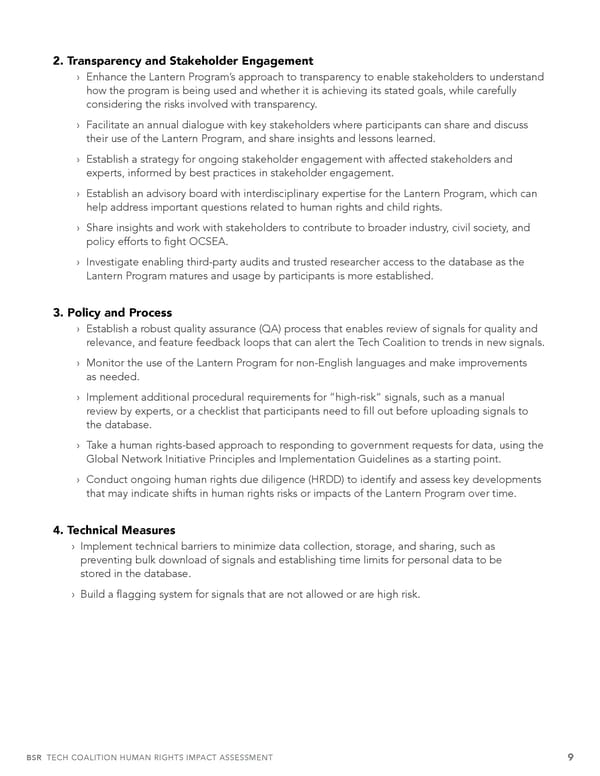2. Transparency and Stakeholder Engagement › Enhance the Lantern Program’s approach to transparency to enable stakeholders to understand how the program is being used and whether it is achieving its stated goals, while carefully considering the risks involved with transparency. › Facilitate an annual dialogue with key stakeholders where participants can share and discuss their use of the Lantern Program, and share insights and lessons learned. › Establish a strategy for ongoing stakeholder engagement with affected stakeholders and experts, informed by best practices in stakeholder engagement. › Establish an advisory board with interdisciplinary expertise for the Lantern Program, which can help address important questions related to human rights and child rights. › Share insights and work with stakeholders to contribute to broader industry, civil society, and policy efforts to 昀椀ght OCSEA. › Investigate enabling third-party audits and trusted researcher access to the database as the Lantern Program matures and usage by participants is more established. 3. Policy and Process › Establish a robust quality assurance (QA) process that enables review of signals for quality and relevance, and feature feedback loops that can alert the Tech Coalition to trends in new signals. › Monitor the use of the Lantern Program for non-English languages and make improvements as needed. › Implement additional procedural requirements for “high-risk” signals, such as a manual review by experts, or a checklist that participants need to 昀椀ll out before uploading signals to the database. › Take a human rights-based approach to responding to government requests for data, using the Global Network Initiative Principles and Implementation Guidelines as a starting point. › Conduct ongoing human rights due diligence (HRDD) to identify and assess key developments that may indicate shifts in human rights risks or impacts of the Lantern Program over time. 4. Technical Measures › Implement technical barriers to minimize data collection, storage, and sharing, such as preventing bulk download of signals and establishing time limits for personal data to be stored in the database. › Build a 昀氀agging system for signals that are not allowed or are high risk. BSR TECH COALITION HUMAN RIGHTS IMPACT ASSESSMENT 9
 Tech Coalition Human Rights Impact Assessment of the Lantern Program Page 8 Page 10
Tech Coalition Human Rights Impact Assessment of the Lantern Program Page 8 Page 10